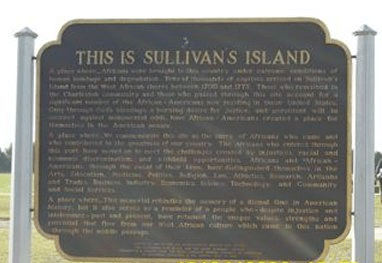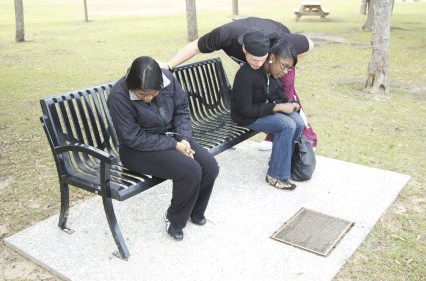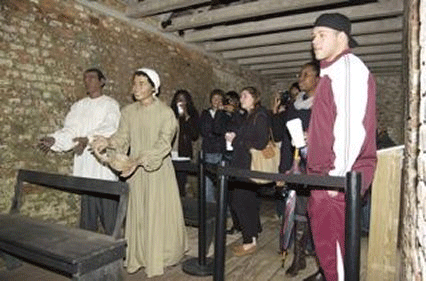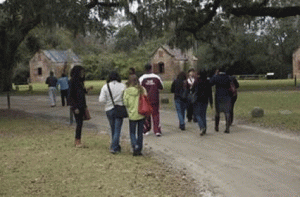It was another day of contrasts for us on our last day in Charleston. The weather was moderate and Mr. Al Miller provided not only transportation but also some umbrellas for the sprinkles of rain that intermittently threatened.
Sullivan’s Island was one of the main ports of entry for enslaved Africans coming to the U.S. It’s estimated that almost half of all African Americans in the U.S. had an ancestor that came through here. We went to see what it looks like today, and found a few poignant reminders of these slaves. The National Parks Service owns the land as part of the Fort Moultrie commemoration. Amid the cannons and Civil War monuments are a plaque and a small exhibit of African passages.
On the inlet side, the Toni Morrison Society last year installed a bench to allow visitors to contemplate those unwillingly brought through the Middle Passage as well as those who did not make it through the journey. As the plaque near the bench explains,
“There is no place you or I can go, to think about or not think about, to summon the presences of, or recollect the absences of slaves; nothing that reminds us of the ones who made the journey and of those who did not make it. There is no suitable memorial or plaque or wreath or wall or park or skyscraper lobby. There’s no 300-foot tower. There’s no small bench by the road.”
In the afternoon we moved on to Boone Hall Plantation, one of the most photographed plantations in South Carolina. We were very excited to discover a bed of cotton growing near the house, and spent several minutes examining the prickly plants, as most of us had never seen it before. Our main focus at Boone Hall was a comparison of their slave cabins to the ones we saw yesterday at the McLeod Plantation. Since Boone Hall is a tourist destination, we found their slave cabin exhibits were created to project mostly positive and happy images of slavery. Before we left, we spent time discussing why it might have been done this way and what we thought about it.
Our song of the day was a chant belonging to the Mbuti people of central Africa which they used to invoke the spirit of their rainforest.
Student Responses
Ewo: Arriving in South Carolina, the place of my birth, and were an estimated eight percent of Africans entered into slavery was for me like paying homage to my ancestors. When I sat “Bench by the Road” and looked out into the river that’s all I could think about and imagine were slave ships on the horizon that undoubtedly carried my great-great grandmother or father. I felt their fears, their tears, and prayers. Again I wondered, could I have been so strong? I did expect to get emotional sometime on the trip, but never did I expect it to be on a solemn bench by the water. I am very happy the monument is there. As Toni Morrison writes, “There is no place you or I can go, to think about or not think about, to summon the presences of or recollect the absences of slaves… There is no suitable memorial…” In its simplicity, I think the memorial is outstanding. For the people who cannot go on a journey like this one and for people who never had a place to reflect, now they have a place. After seeing this, I definitely expect another time or two that I expect to cry, to feel, and again live in the presence of the past.
Jared: While visiting Sullivan’s Island we took a walk out to the waterfront where the Toni Morrison Society donated a bench to sit as a remembrance. As you walk out on the dock along the water, 60 degree weather, nice light breeze, marsh lands dividing the water outlets close to shore— a setting that one could typically sit and relax and free his or her mind from any worries in the world. Then you realize again where you are, the location in which many Africans were brought as they were taken from their homeland and brought to be slaves in this foreign country. This is the case for many different locations and sites across the South and America as a whole; while we enjoy and take these sites in, one must remember that a lot of them were done on the backs of Black slave men, women, and children.As you visit and sit on this bench donated by the Morrison Society, it is designed to make you not only take in the beauty of the moment but remember at what cost it was made possible.
Jamie:
For me, Boone Hall stood in marked contrast to Sullivan’s Island. While at McCleod plantation I felt as though I was in the presence of history. This was largely due to the fact that the buildings had not been maintained over the years, and therefore I knew I was looking at the exact same structures that slaves and their owners had looked at over two hundred years ago. We were given the unique opportunity to stand inside one of the slave cabins which brought about many questions and emotions. When standing inside an original slave cabin my mind ran wild with images of what had gone on in the room I was standing in. It was unbelievable to stand in the same room as families had years ago and wonder what had gone on in that room.
Upon arriving at Boone Hall plantation it was easy to tell that the slave cabins were not in their original condition. I felt as though this took away from its power. I likened this to my experience on my term abroad in China. I was fortunate enough to walk on two sections of the Great Wall. The first section had been restored using modern technology and although stunning, I was not able to feel as though I was in the presence of a historically significant object. However, the second section of the Wall I climbed was in its original state and was crumbling in several sections. While I know that this section of the Wall will eventually deteriorate, I was able to look at it and know that those stones had not been moved in thousands of years, thus making the Wall more historically significant.
What shocked me more about Boone Hall plantation was the information that was shared about living conditions for slaves. Slave cabins were decorated with luxuries that would not have been available, most notably a large pantry full of food and nice clothing on the manikins. The final cabin was especially thought provoking for me because it summarized the entire African American experience in the United States in a two minute video highlighting the “progress” that had been made. The video ended in a crescendo showing President Obama, signifying that the struggle was over. To me, this video seemed to portray slavery as an American success story; with citizens willingly realizing that they were wrong and granting freedom and equality to black citizens.
Our group discussed the reality that the majority of Americans do not want to pay to visit a monument that will make them uncomfortable… I felt as though the historical “picking and choosing” took away from the significance of Boone Hall plantation, while McCleod plantation allowed us to have our own experiences and made no attempt to justify the actions of slave owners by stating that conditions were tolerable and slaves were content.
Sarayfah: Boone Hall highlighted the “numbness” that exists in the black community in the South. The fact that the café displayed racialized figurines for customers to purchase was not only shocking, but was degrading. What struck me the most about the figurine of the “mammy” was that she was fat with a red bonnet and the only facial features that were distinguishable were her eyes. Why is this a top selling item at Boone Hall? Why do people look at this figurine and describe it as “cute”? The fact that a “numbness” exists leads me to believe that racism still exists. Taking small actions like refusing to buy these figurines speaks volumes. It almost begs the need for another movement to ensure that history is displayed accurately. The black community HAS TO awaken from its tolerance of just making it and brushing off insults and regain pride in what it means to be an African-American.










